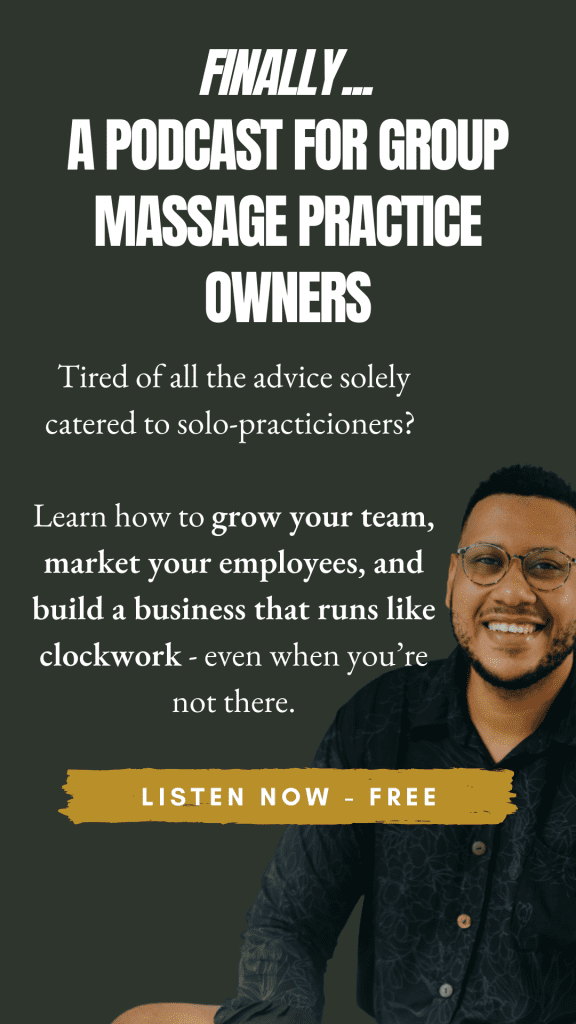In today’s competitive wellness landscape, running a group massage practice comes with unique challenges—but also exciting opportunities. With multiple practitioners under one roof, you can offer a variety of specialties, longer hours, and a more robust client experience. To truly thrive, however, you must stand out both online and in your community. In this in-depth guide, we’ll explore effective, SEO-friendly marketing strategies to help your group massage practice grow and succeed.
1. Establish a Strong Brand Identity
a) Define Your Practice’s Core Values
A strong brand identity starts with knowing who you are and what you stand for. Identify the primary values and unique selling points (USPs) that set your group practice apart:
- Comprehensive Specialties: Therapeutic massage, sports massage, prenatal massage, hot stone, aromatherapy, reflexology, etc.
- Team Expertise: Highlight each therapist’s credentials, areas of specialization, and years of experience.
- Holistic Approach: Emphasize a client-first philosophy and the synergy of working as a group.
b) Create a Memorable Brand Name and Visuals
Your business name, logo, and color palette should resonate with your target audience. Ensure they reflect the calm, healing environment your group provides:
- Logo: Aim for simplicity and clarity—something that conveys relaxation and wellness.
- Color Scheme: Soothing shades like blues, greens, or neutrals can help evoke a sense of tranquility.
c) Consistency Across All Channels
From your website to social media and printed materials, maintain consistent branding elements. This uniformity builds trust and recognition among potential clients.
2. Optimize Your Online Presence (SEO Best Practices)
a) Keyword Research
To attract clients online, your website must rank well on search engine results pages (SERPs). Begin with targeted keyword research:
- Short-Tail Keywords: “Massage therapy,” “massage practice,” “sports massage.”
- Long-Tail Keywords: “Group massage practice in [Your City],” “prenatal massage therapy for back pain,” “holistic healing center with multiple therapists.”
Use SEO tools like Google Keyword Planner or Ahrefs to identify terms relevant to your services and local market.
b) On-Page Optimization
Ensure each page on your website is optimized for both search engines and user experience:
- Meta Titles & Descriptions: Incorporate your primary keyword naturally.
- Example: “Group Massage Practice in [City] – Holistic Healing and Relaxation”
- Headers (H1, H2, H3): Use clear, keyword-rich headings to outline each page’s content.
- URL Structure: Keep URLs short and descriptive.
- High-Quality Content: Write detailed service pages explaining the benefits of each therapy method, the qualifications of your team, and the outcomes clients can expect.
c) Local SEO
Most massage clients come from nearby communities. Make local SEO a priority:
- Google Business Profile: Create or claim your listing, add high-quality photos, and encourage clients to leave reviews.
- Local Citations: Ensure your name, address, and phone number (NAP) are consistent on directories like Yelp, Bing Places, and local business directories.
- Location Pages: If your group has multiple locations, dedicate a page to each to optimize for hyper-local keywords.
d) Mobile Optimization
Many potential clients search for massage services on their phones. Make sure your website is mobile-responsive with quick-loading pages, easy navigation, and clickable contact information.
3. Leverage Content Marketing
a) Educational Blog Posts
A blog is an excellent platform to showcase your expertise and improve SEO. Consider topics like:
- “5 Benefits of Regular Group Massage Sessions”
- “How to Choose the Right Massage Therapist for Your Needs”
- “What to Expect During Your First Massage at a Group Practice”
Aim for in-depth, keyword-optimized posts that answer common client questions. This positions your practice as a trusted resource in the wellness community.
You can also learn from effective medical massage marketing strategies to position your group practice as a trusted therapeutic provider without feeling salesy or pushy.
b) Video Content
Not everyone enjoys reading long articles—some prefer visual learning. Publish short videos on YouTube, TikTok, or Instagram demonstrating:
- Massage Techniques: Show the benefits and the process of various modalities.
- Therapist Introductions: Let each therapist record a brief greeting to build a personal connection.
- Client Testimonials: With permission, highlight success stories or experiences to build trust.
c) Social Media Marketing
A robust social media presence can drive engagement and boost brand awareness:
- Facebook & Instagram: Share tips, behind-the-scenes looks, and special promotions.
- LinkedIn: Ideal for professional networking and B2B collaborations.
- Hashtags & Location Tags: Use relevant hashtags (#MassageTherapy, #WellnessJourney) and always tag your city or region to attract local audiences.
4. Build Strategic Community Partnerships
a) Collaborate with Complementary Businesses
Join forces with businesses that share a similar target market but aren’t direct competitors. Examples include:
- Yoga Studios: Offer combined packages or reciprocal discounts.
- Gyms & Fitness Centers: Provide on-site chair massage demos to attract clients seeking post-workout recovery.
- Chiropractors & Physical Therapists: Develop referral networks to share clients needing additional care.
b) Host Workshops or Community Events
Establish your group practice as a local health and wellness authority:
- Open House Events: Invite the community to meet your therapists, tour the facility, and enjoy free mini-massages.
- Educational Seminars: Partner with local health professionals to discuss pain management, stress relief, and holistic living.
- Charity or Fundraising Events: Donate your services or partner with nonprofits to raise awareness for a cause, showcasing your community involvement.
5. Encourage Word-of-Mouth & Referrals
a) Incentivize Referrals
Clients who love your service can be your most powerful ambassadors. Offer discounts, loyalty points, or complementary add-ons when they refer friends and family:
- Referral Cards: Give clients a card they can pass along, redeemable for a free add-on or discounted session.
- Digital Referral Links: Provide unique referral codes or links for easy online sharing.
b) Loyalty Programs
Reward returning clients with a tiered points system or monthly membership. This not only boosts retention but also appeals to budget-conscious customers who want consistent care.
c) Online Reviews
Encourage satisfied clients to leave Google, Yelp, or Facebook reviews. Positive reviews:
- Enhance Local SEO: Google favors businesses with higher ratings and reviews.
- Build Trust: Many people rely on peer endorsements to make purchasing decisions.
6. Harness the Power of Email Marketing
a) Build an Email List
Email remains one of the most effective marketing channels for nurturing relationships:
- Website Signup Form: Offer a free resource (e.g., “5 Tips for Better Posture at Work”) in exchange for an email address.
- Appointment Reminders: Capture emails when clients book sessions.
b) Segment Your Audience
Divide your email list into categories (e.g., new clients, frequent clients, corporate partners) and send tailored content:
- Welcome Series: Offer an introductory discount for new subscribers and explain how the group practice works.
- News & Updates: Highlight upcoming events, new therapists, or exclusive promotions.
- Educational Content: Share self-care tips, wellness insights, and product recommendations.
c) Consistent and Valuable Communication
Avoid spammy or pushy emails. Aim to provide real value:
- Monthly Newsletters: Summaries of blog posts, therapist spotlights, client success stories.
- Seasonal Promotions: Theme your promotions around holidays, awareness months, or local events.
7. Offer Unique Promotions & Packages
a) Group Deals
Encourage clients to bring friends or family:
- Friends or Couples Massage Packages: Discounts for pairs or small groups to experience massage together.
- Bulk Session Discounts: Encourage clients to book multiple sessions upfront (e.g., buy five sessions, get one free).
Also Learn: How to promote and market couples massages effectively to fill these packages consistently.
b) Corporate & Workplace Wellness
Partner with local businesses to provide in-office chair massages or discounted group rates for employees:
- Corporate Wellness Packages: Offer monthly visits to help reduce workplace stress and improve morale.
- Subscription Model: Businesses can set a budget for employee massages, creating steady revenue for your practice.
c) Seasonal Offers
Design special deals around busy seasons (e.g., “Back-to-School Stress Relief” or “Holiday De-Stress Package”). Seasonal promotions keep your marketing fresh and relevant.
8. Monitor and Adjust Your Strategy
a) Track Key Performance Indicators (KPIs)
Measure the success of your marketing to understand what resonates and where you can improve:
- Website Traffic & Conversions: Use Google Analytics to see how users navigate your site and book appointments.
- Local Rankings: Track your placement in local search results for relevant keywords.
- Social Media Engagement: Monitor likes, comments, shares, and clicks.
- Email Open & Click-Through Rates: Refine your email content based on engagement metrics.
b) Collect Client Feedback
Regularly survey your clients about their experience:
- Service Satisfaction: Are they satisfied with the booking process, wait times, and overall therapy experience?
- Suggestions for Improvement: Encourage them to share ideas that could enhance your group practice.
c) Stay Agile
Digital marketing evolves quickly, and your audience’s needs may change. Continuously refine your approach:
- A/B Test Ads and Emails: Test different headlines, images, and offers to find what works best.
- Update Content: Refresh blog posts or service pages with the latest research, techniques, and visuals.
Conclusion
Marketing a group massage practice requires a multi-faceted approach that integrates strong branding, SEO-optimized online presence, strategic partnerships, and exceptional client experience. By focusing on local SEO, leveraging word-of-mouth referrals, and engaging with your community, you can attract and retain loyal clients who value the diverse skill set and holistic environment your group offers.
Start by refining your brand identity, optimizing your website for local searches, and creating educational, shareable content. Engage in consistent outreach to local businesses and offer compelling promotions to convert leads into loyal patrons. With ongoing performance tracking and adaptation, your group massage practice can thrive, ensuring a steady flow of clients who appreciate the healing power of massage—and your commitment to delivering it. For more proven systems, templates, and guides to grow your massage business confidently, visit Scaling Wellness to access industry-leading resources.





